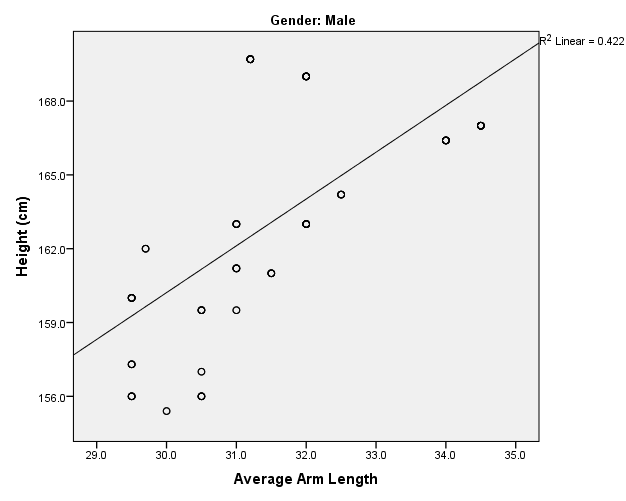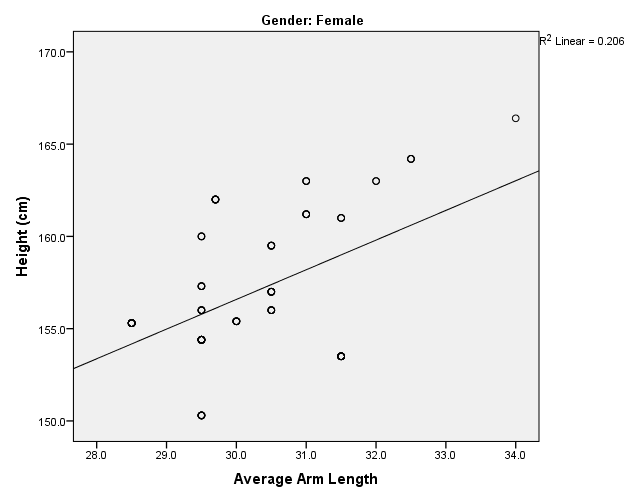Introduction
Stature estimation is obtained from measurements of long bones; namely the humerus, femur, and tibia. If these bones are unavailable, the ulna, radius, and fibula can also provide a good range for the expected height of an individual. As many elements as possible should be used in a regression equation to estimate stature. Incomplete fragments can be used to estimate height, by first estimating the complete length of bone from a regression equation before applying the original formula to estimate stature.1, 2
Since stature is variable among population and sex, there are different regression formulas for different populations. Therefore, determining which regression formula to use is an important aspect of stature estimation. It is necessary to know the population from which an individual is from and the individual’s sex when selecting a formula.3
The humerus can be broken down into four segments. If the humerus is found in its entirety, then its length can be used to estimate stature. However, if only segments of the humerus are recovered then a combination of segments can be used to estimate stature.4, 5
Segment 1 is identified as the entirety of the humeral head
Segment 2 is identified as between the most distal point of the head and the most proximal margin of the olecranon fossa.
Segment 3 is identified as the entirety of the olecranon fossa, from the most proximal to the most distal margins.
Segment 4 is identified as between the most distal margin of the olecranon fossa, and the most distal point of the trochlea.
Materials and Methods
A cross sectional study was carried out using purposive sampling among Medical Students at CIMS, Chamarajanagar. Study duration was 6 months from July 2019 to December 2020. 100 Male and 100 Female Medicos were included in the study after taking informed consent. Differently abled adults were excluded from the study to reduce the error. Structured questionnaire was used to collect the data such as age, gender, height, arm length or Humerus length and distance between medical and lateral condyle.
Equipment’s used are as follows6, 7
Anthropometer II spreading caliper III skin marking pencil
Measurements were taken at a fixed time, to avoid diurnal variations. Any obvious deformity or limb defects were not included in the present study. The height of the subject was measured by standard height measuring instrument in anatomical position. The length of humerus was taken by asking the subject to flex the elbow joint. The flexor surfaces of arm and forearm made an angle of 90 degrees. Lateral epicondyle was felt and marked with skin marking pencil. Acromion point was traced by moving finger over clavicle’s lateral end and was marked and the distance between two points was measured by spreading caliper, both side humerus length was taken. The measured length was subtracted by 2.0 mm as the acromion point is 2 to 5 mm above humeral head.
Statistical methods
Data was analyzed using SPSS 22 version software (IBM SPSS Statistics, Somers NY, USA). Categorical data was represented in the form of Frequencies and proportions. Continuous data was represented as mean and standard deviation. Independent t test was used as test of significance to identify the mean difference between two quantitative variables.
Pearson correlation was done to find the correlation between two quantitative variables.
Regression
Linear regression was done to find the regression equation and to estimate the unknown quantitative variables when one quantitative variable is known.
The regression equation is a linear equation of the form: y = b0 + b1x
Y = Dependent variable, X = Independent variable, b0 = Constant B, b1 = Unstandardized Coefficients of Independent variable.
Results
Table 2
Age and anthropometric parameters distribution between males and females
Mean age of Males was 19.20 ± 0.91 years and females were 19.24 ± 0.82 years. There was no significant difference in mean age between two groups.
Mean Height of males was 163.16 ± 4.55 cm and among females was 156.83 ± 3.77 cm. There was significant difference in mean height between males and females.
Mean Average Arm Length among males was 31.55 ± 1.56 cm and among females was 30.15 ± 1.07 cm. There was significant difference in mean average arm length between males and females.
Mean Distance between medial & lateral epicondyle among males was 13.73 ± 1.70 cm and among females was 11.84 ± 1.42 cm. There was significant difference in mean Distance between medial & lateral epicondyle between males and females.
Table 3
Correlation between arm lengthor humerus length with age, height and distance between medial & lateral epicondyle
In the study among males there was significant positive correlation between Humerus length and Height and Distance between medial & lateral epicondyle i.e. with increase in Humerus length there was increase in height and Distance between medial & lateral epicondyle and vice versa.
Among females there was negative correlation between Humerus length and age i.e. with increase in age there was decrease in Humerus length and vice versa. The correlation was statistically significant.
Among females there was significant positive correlation between humerus length and height and distance between medial & lateral epicondyle i.e. with increase in Humerus length there was increase in height and Distance between medial & lateral epicondyle and vice versa.
Table 4
Linear regression between Humerus length and height
Discussion
The estimation of height of the person from the long bones is practiced worldwide in clinical and forensic field of medicine throughout the world. But in this present study we have tried to evaluate the height of the stature of the persons from the long bones of Upper body.
Various author in the past have shown that there is statistical significant between the height of the person and different parts of the body but mostly and majority of them had done on lower extremity of long bones, further the study on estimation of height from the long bone of the upper extremity of the body had been very sparse and very minimal data is available.
It is to be noted that for identification of any person in the field of forensic the height of the person is one of the method. In order to obtain he height of the person the long bones are usually evaluated and if the long bones are fractured the fractured fragments of the long bone need to be assembled and height is estimate. In this study we are calculating the stature of the person by examining the length of the Humerus.
In the present study it was estimated that the average length of Male was 103.1 + 1.903 x Arm length and among female it was 108.34 + 1.608 x Arm length by using regression equation. In the study done by Borkar M P et al. 8 also demonstrated that regression equation can be used in estimating length of stature from the size of the humeurs. In studies done by Krishan and Kanchan et al. 9 also opined in their study that stature estimation can be evaluated using regression analysis method than multiplication factor method.
Few other studies done by Kapoor et al., Vijetha et al. findings were also co relating and similar to our study findings.10, 11
Further it was also established that by knowing the length of the humerus it will be possible for estimating stature of the person.
Conclusion
The present study enchane the known knowledge of the fact that estimation of the stature is one of the important method used in the identification of the person can be done by long bones of the upper extremities also. It will help further in the field of forensic, anatomy and even in archeological case where unknown bodies need to be examined. It is also helpful for the clinician in the treatment of proximal and distal humeral fractures. Therefore, the present study supplies the mean values of the different morphometric measurements from the humerus.


